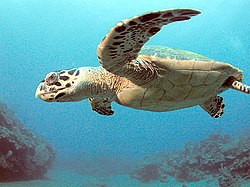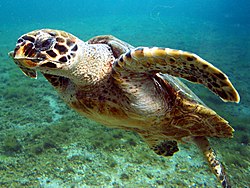Hawksbill sea turtle
The hawksbill sea turtle or hawksbill turtle (Eretmochelys imbricata) is an endangered species of turtle. It is mostly seen in shallow lagoons and coral reefs where its food is. It is smaller than the Australian flatback turtle: it is usually a little more than two feet long.
| Hawksbill sea turtle | |
|---|---|

| |
| Eretmochelys imbricata | |
| Conservation status | |
| Scientific classification | |
| Kingdom: | |
| Phylum: | |
| Class: | |
| Order: | |
| Suborder: | |
| Superfamily: | |
| Family: | |
| Subfamily: | |
| Genus: | Eretmochelys Fitzinger, 1843
|
| Species: | E. imbricata
|
| Binomial name | |
| Eretmochelys imbricata | |
| Subspecies | |
| |

| |
| Range of the Hawksbill turtle | |
It usually weighs about 150 pounds. It has the most pointed beak among sea turtles, which is how it gets its name. The hawksbill gets food from inside coral reefs, eating sponges, shrimp, squid, and other invertebrates.[2] The hawksbill pointy beak helps the turtle get food out of the tiny cracks and holes in which it searches. Though they are sometimes seen in American waters, hawksbill turtles almost always nest in the warmer climates that run along the equator. Because people use the shell to make jewelry and other things, the hawksbill turtle is endangered.
Description
Adults are typically 1 meter (3 ft) long, weighing up to 80 kg (180 lb) on average. Larger ones can weigh up to 127 kg (280 lb).[3] This species was originally named Testudo imbricata in 1766. It was moved to the genus Eretmochelys in 1843.
There are two known subspecies within the species Eretmochelys imbricata: Eretmochelys imbrica imbrica and Eretmochelys imbrica brissa.[2][3]
Diet
Hawksbill sea turtle is a ornivorous species that feeds mainly on sea sponges. They can also feed on small octopuses, sea snails and algae.[4]
Hawksbill Sea Turtle Media
Hawksbill sea turtle (top right) in a 1904 plate by Ernst Haeckel
Hawksbill sea turtle in Saba, Netherlands Antilles
A hawksbill turtle foraging on the reefs at Ilha do Fogo, Mozambique
Young E. imbricata from Réunion Island
E. imbricata in a coral reef in Venezuela
A female hawksbill turtle laying eggs on beach at Mona island, Puerto Rico
Hawksbill hatchling in Paulista, Pernambuco, Brazil
A hawksbill sea turtle in Tobago
References
+{{{1}}}−{{{2}}}
| Wikimedia Commons has media related to Lua error in Module:Commons_link at line 62: attempt to index field 'wikibase' (a nil value).. |
| Wikispecies has information on: Turtle. |
- ↑ Mortimer, J.A.; Donnelly, M. (IUCN SSC Marine Turtle Specialist Group). (2008). "Eretmochelys imbricata". IUCN Red List of Threatened Species. IUCN. 2008: e.T8005A12881238. doi:10.2305/IUCN.UK.2008.RLTS.T8005A12881238.en. Retrieved 16 May 2024.
- ↑ 2.0 2.1 Mortimer, J.A & Donnelly, M. (IUCN SSC Marine Turtle Specialist Group) (2008-06-30). "IUCN Red List of Threatened Species: Eretmochelys imbricata". IUCN Red List of Threatened Species.
{{cite journal}}: CS1 maint: multiple names: authors list (link) - ↑ 3.0 3.1 "VDGIF > Wildlife > Species > hawksbill (= carey) sea turtle". www.dgif.state.va.us. Retrieved 2025-08-09.
- ↑ Meylan, Anne (1988-01-22). "Spongivory in Hawksbill Turtles: A Diet of Glass". Science. 239 (4838): 393–395. doi:10.1126/science.239.4838.393.










